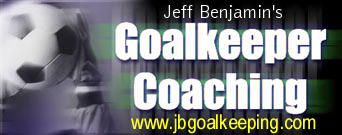
|
"Outstanding keeper instruction. This is a must for goalkeepers and coaches." — Ottawa Internationals S.C. web site, Ottawa, Canada |

|

|
|
|
Top |
Next: Catching
|
Angle play: This area alone separates the pretenders from the contenders. By simply taking up the right position you can make goalkeeping look very easy.
-- Tony DiCicco, Goalkeeper Soccer Training Manual
| CONTENTS | TRAINING SESSIONS |
|---|---|
|
Basic Positioning Principles
Positioning Around the Goal Quick Summary/Mistakes to Watch For Related Blog Entries |
General Positioning |
Along with footwork and good catching skills, positioning provides the foundation of good goalkeeping. A keeper who is always in position makes it look like every shot goes right to them, because the shooter has nowhere else to put the ball. Poor positioning leaves vast areas of net for a shooter, or even an empty net.
Basic Positioning Principles
 Fig 1. The Center Line Position |
 Fig. 2 Covering the Angle |
First, to position themselves accurately, the goalkeeper must know
where the goal is! It sounds obvious, but during the scramble of a
game a keeper can lose track. When the play starts moving towards the
goal, ![]() the first thing
the keeper must do is check the posts to make sure they are starting
off with good position. Then, whenever they can divert their attention
for a split second, they should check the posts again to make sure they've
maintained that good position in the face of a moving ball.
the first thing
the keeper must do is check the posts to make sure they are starting
off with good position. Then, whenever they can divert their attention
for a split second, they should check the posts again to make sure they've
maintained that good position in the face of a moving ball.
Second, the goalkeeper must always try to position themselves on an imaginary line that runs from the center of the goal to the ball (Fig. 1). This puts them in position to get to either post equally well. The center line determines the side-to-side positioning.
Third, the goalkeeper must position themselves far enough off the
goal line to cover the angle created by the ball and both posts. They
should be able to cover either post with a couple of quick steps
(footwork!) and a dive if necessary (Fig. 2).
The angle and the keeper's ability determine the forward/backward positioning.
![]() Many young or timid goalkeepers
tend to stay very close to the goal line - sometimes right on it. They
must be taught to come off the line if they are to cover any shots
near the posts.
Many young or timid goalkeepers
tend to stay very close to the goal line - sometimes right on it. They
must be taught to come off the line if they are to cover any shots
near the posts.
How far out a keeper must come depends on their size and ability - smaller goalkeepers or keepers with a poor range will need to come farther out to be able to cover the entire angle.
But don't forget the third dimension not represented in these pictures: height. A keeper who is far off their line is more likely to be beaten by a chip over their head, so that must also be put into the equation. The keeper must adjust the forward/backward position so that they're confident they won't be beaten easily over the top.
Positioning Around the Goal
The goalkeeper must constantly adjust his or her position as they move around the goal. Let's look at what happens as the ball changes spots.
 Fig. 3: The Goalkeeper's Arc |
 Fig. 4 Adjusted Arc |
At a tight angle, with the ball near the end line, the angle the keeper
needs to cover is very small, so they can stay near their goal.
However, the keeper ![]() must stay outside the near post. This will prevent them from
must stay outside the near post. This will prevent them from
![]() deflecting a shot into their
own net inside the near post. At sharp angles the goalkeeper should
always position themselves so any ball they deflect at a right angle
(they should already be square to the ball) will go outside the near
post.
deflecting a shot into their
own net inside the near post. At sharp angles the goalkeeper should
always position themselves so any ball they deflect at a right angle
(they should already be square to the ball) will go outside the near
post.
Here's a quick way for goalkeepers to tell if they are outside the near
post: ![]() if the goalkeeper, while square to the ball, points their arms
straight out sideways, the arm nearest the goal should be pointing
outside the near post. If it is pointing into the net, the keeper needs
to take another step or two out from goal.
if the goalkeeper, while square to the ball, points their arms
straight out sideways, the arm nearest the goal should be pointing
outside the near post. If it is pointing into the net, the keeper needs
to take another step or two out from goal.
As the ball moves further out onto the soccer field, the near post is not as much of a concern any more, but the keeper must move further out to cover the angle.
Figure 3 shows conceptually where a keeper should be positioned (red dots) as the ball (black dots) moves around the edge of the penalty area. The blue line shows the shape this makes. The actual size of the arc will differ depending on the size and skill of a particular keeper, but the general shape will remain the same. (The angle lines are only drawn on the left side of the illustration to avoid clutter.)
If we look at the top of the arc, though, we notice that the keeper is
very far off the line (sometimes 10-12 yards out!)
and likely to get chipped, especially if they're
not very tall. So we need to ![]() adjust the top of the arc to account for high balls. The top of the
arc gets flattened, bringing the keeper back to a position where they
have a chance to get to any ball over their head (Fig. 4). Again,
the exact position will depend on the size and skill of the player.
Shorter, less skilled keepers will be more comfortable closer to the
goal line, others may be comfortable closer to the six.
adjust the top of the arc to account for high balls. The top of the
arc gets flattened, bringing the keeper back to a position where they
have a chance to get to any ball over their head (Fig. 4). Again,
the exact position will depend on the size and skill of the player.
Shorter, less skilled keepers will be more comfortable closer to the
goal line, others may be comfortable closer to the six.
Tony DiCicco calls this concept the "Arc Angle".
![]() It can easily be
demonstrated on the soccer field with three ropes about 50 feet long, one
attached to each post and one to a stake at the middle of the goal line.
Place the ball at varying spots around the penalty area and have the
keeper find their position, then place a cone there. When the exercise
is finished, the cones will show that keeper's arc as in Figure 3.
Adjust for chip shots and you'll end up with the keeper's arc as
in Figure 4.
It can easily be
demonstrated on the soccer field with three ropes about 50 feet long, one
attached to each post and one to a stake at the middle of the goal line.
Place the ball at varying spots around the penalty area and have the
keeper find their position, then place a cone there. When the exercise
is finished, the cones will show that keeper's arc as in Figure 3.
Adjust for chip shots and you'll end up with the keeper's arc as
in Figure 4.
A keeper should learn this arc and use it as a general guideline for
how they position themselves as the ball moves.
Notice that this arc roughly follows the goal box.
![]() Make sure the keeper notes
how their own arc matches or differs from the goal box, so they can use
the goal box as a reference during practices and games.
However,
Make sure the keeper notes
how their own arc matches or differs from the goal box, so they can use
the goal box as a reference during practices and games.
However,
![]() do not let a keeper, especially
a young one, think they must move along this arc at all times. If the
ball quickly changes position, they must move as quickly as possible to
cover the new position, cutting across the box if necessary.
do not let a keeper, especially
a young one, think they must move along this arc at all times. If the
ball quickly changes position, they must move as quickly as possible to
cover the new position, cutting across the box if necessary.
Also, remember a given keeper's arc will change as they gain size, strength and ability. You may want to run the exercise with the ropes once a season to see if their arc has changed.
Positioning Within the Penalty Area
Discussion of where the goalkeeper should be in the penalty area when the ball is elsewhere on the soccer field is in the tactics section.Quick Summary - Positioning: |
Mistakes to Watch For: |
||||||||
|
|
|
|
|
Top |
Next: Catching
|